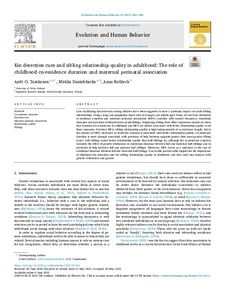Kin detection cues and sibling relationship quality in adulthood: The role of childhood co-residence duration and maternal perinatal association
Tanskanen Antti O.; Danielsbacka Mirkka; Rotkirch Anna
https://urn.fi/URN:NBN:fi-fe2021102752634
Tiivistelmä
Abstract
Cues facilitating kin detection among children have been suggested to have a profound impact on adult sibling relationships. Using a large and population-based data of younger and middle-aged Finns, we test how childhood co-residence duration and maternal perinatal association (MPA) correlate with contact frequency, emotional closeness and provision of help between adult siblings. Employing sibling fixed-effect regression models we show that duration of co-residence in childhood and MPA are indeed associated with better relationship quality in all three measures. Provided MPA, sibling relationship quality is high independently of co-residence length, but in the absence of MPA, increased co-residence duration is associated with better relationship quality. Co-residence duration is more strongly associated with provision of help between opposite-gender than same-gender sibling dyads. Full siblings report better relationship quality than half siblings do, although the co-residence duration mediates the effect of genetic relatedness in emotional closeness between full and maternal half siblings and in provision of help between full and paternal half siblings. Moreover, MPA serves as a mediator in the case of emotional closeness between full and maternal half siblings. Our results provide solid support for the importance of childhood kin detection cues for sibling relationship quality in adulthood, and how such cues interact with genetic relatedness and gender.
Kokoelmat
- Rinnakkaistallenteet [27094]
